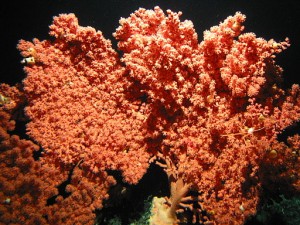Global habitat suitability of cold-water octocorals
Chris Yesson, Michelle L. Taylor, Derek P. Tittensor, Andrew J. Davies, John Guinotte, Amy Baco, Julie Black, Jason M. Hall-Spencer and Alex D. Rogers

Paragorgia arborea from NOAA’s photolibrary
Three-quarters of Octocorallia species are found in deep waters. These cold-water octocoral colonies can form a major constituent of structurally complex habitats. The global distribution and the habitat requirements of deep-sea octocorals are poorly understood given the expense and difficulties of sampling at depth. Habitat suitability models are useful tools to extrapolate distributions and provide an understanding of ecological requirements. Here, we present global habitat suitability models and distribution maps for seven suborders of Octocorallia: Alcyoniina, Calcaxonia, Holaxonia, Scleraxonia, Sessiliflorae, Stolonifera and Subselliflorae.
Methods: We use maximum entropy modelling to predict octocoral distribution using a database of 12,508 geolocated octocoral specimens and 32 environmental grids resampled to 30 arc-second (approximately 1 km2) resolution. Additionally, a meta-analysis determined habitat preferences and niche overlap between the different suborders of octocorals.
Results: Suborder Sessiliflorae had the widest potential habitat range, but all records for all suborders implied a habitat preference for continental shelves and margins, particularly the North and West Atlantic and Western Pacific Rim. Temperature, salinity, broad scale slope, productivity, oxygen and calcite saturation state were identified as important factors for determining habitat suitability. Less than 3% of octocoral records were found in waters undersaturated for calcite, but this result is affected by a shallow-water sampling bias.
Main conclusions: The logistical difficulties, expense and vast areas associated with deep-sea sampling leads to a gap in the knowledge of faunal distributions that is difficult to fill without predictive modelling. Global distribution estimates are presented, highlighting many suitable areas which have yet to be studied. We suggest that approximately 17% of oceans are suitable for at least one suborder but 3.5% may be suitable for all seven. This is the first global habitat suitability modelling study on the distribution of octocorals and forms a useful resource for researchers, managers and conservationists.
Request PDF
| To request a PDF copy of this paper, please enter your email address below: Your email address is not stored, it is only used to send an email with an attached PDF to you. |
Full citation
Yesson C, Taylor ML, Tittensor DP, Davies AJ, Guinotte J, Baco A, Black J, Hall-Spencer JM, Rogers AD (2012) Global habitat suitability of cold-water octocorals. J Biogeogr 39:1278-1292
